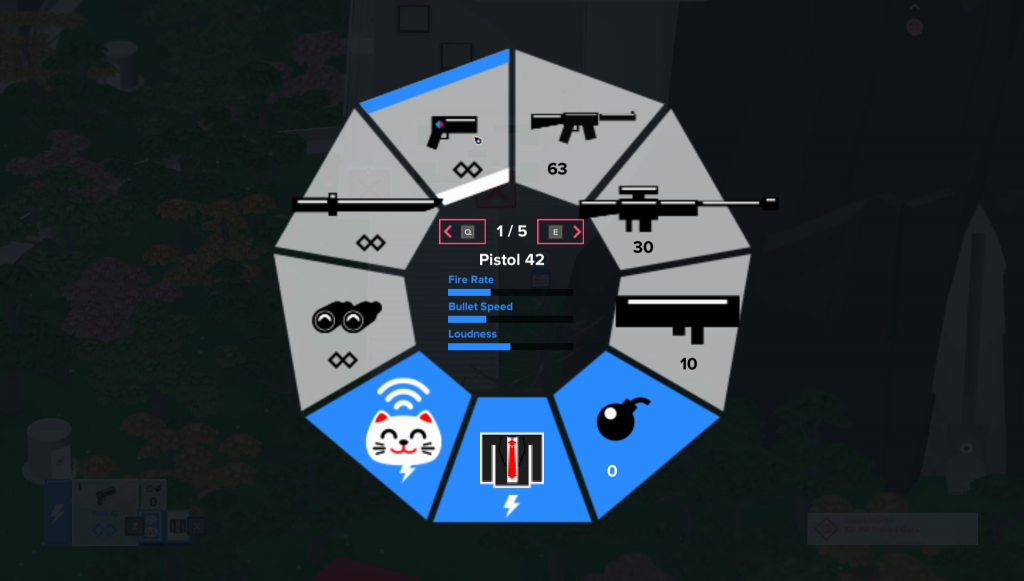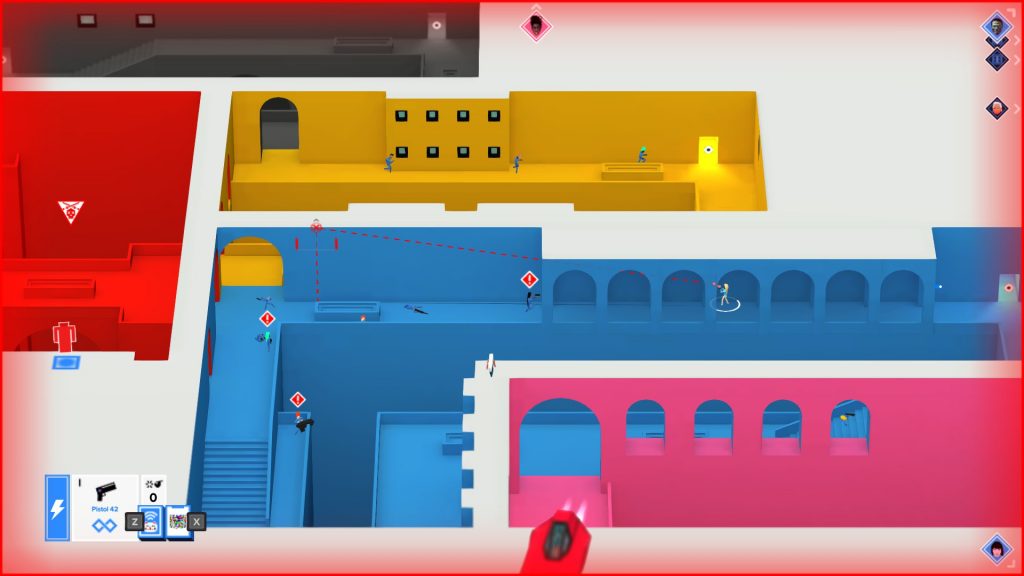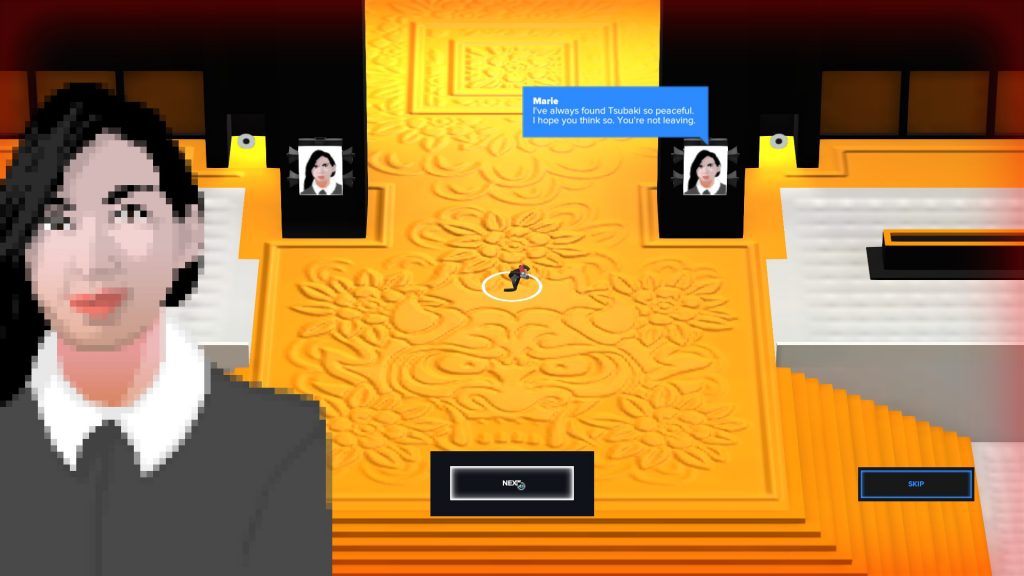Tokyo 42: The Meaning of Death
In Douglas Adams’ Hitchhiker’s Guide to the Galaxy series, through various muddles we wound up with the number 42 as the answer to the ultimate question of life, the universe, and everything. Many fan theories outline the choice behind the number, but my favourite -even if it is morbid- states that it is the sum of the dots on two die – ergo, the answer, to die. In Tokyo 42 the number means many things and occurs many times, however at no point does it mean to die, mainly because -thanks to megacorporation Nano Med- death is no longer an issue.

It’s 2042, most of the world has been destroyed. Tokyo has, however, thrived; a seemingly blissful, brightly coloured rooftop city peeking out from an ocean of clouds. What’s below, what’s left of the rest of the world? We never find out, everything we need is littered across those rooftops, from the looming cathedral, to the busy market district, and the various recreational areas. Peel back the cheerful, bright skin of Tokyo and the game is closer in nature to traditional cyberpunk – brands, gangs, megacorps, and technology drive the game forward.
You, an unremarkable nobody, are woken by a vid-call from your friend Tycho. Somebody is dead -and not just dead, no, dead-dead- and you’ve been framed for it. Following his advice you skip the shower and make a bolt for it – well, frankly, everybody then walks into the shower because they can. The police aren’t stopping to ask questions so you take to the skies in Tycho’s hovercar after narrowly dodging a flurry of gunshots. The plan? Do what any self-respecting video game or movie protagonist who has been framed for assassination does – hit the road as a gun for hire, killing your way to the top as to find out who is responsible for you (an innocent who would never assassinate someone) being framed.
Surprisingly, even though there’s a company making medication which ensures you don’t die, murder is a big business. Not least because that medication isn’t free, and also because getting killed is still a bit of a handicap mentally. It might be super-cool that you can plummet to your painful death, get stabbed by a katana wielding mentalist, or get blown up by a bouquet of grenades and then simply get back up as right as rain, but, you can bet that it sticks in your mind – that you won’t be quite so interested in venturing down that path again. That’s the extent of many of your early contracts, well, that and ones where you’re making someone late for work, or they happen to not be on their meds that day.

The isometric viewpoint of the game lends itself well to Tokyo 42’s rooftops, better yet a handy indicator is anchored to you when you leap, which does a great job of ensuring that the only reason you’re going to miss a jump is due to a failure to correctly gauge a distance. That said, that will probably happen a lot – the game’s camera system pivots between 8 directions in single step-movements at the players request. It’s an interesting decision, and with many of the buildings designed and shaped to match those axes the game’s slower, exploratory, and platforming moments channel classic perspective-puzzler Fex. One of the times when Tokyo & the camera system are at their best are when you’re ambling around windows and ledges as to collect cat designs, coats, weapon skins, or to open map shortcuts by finding hidden buttons.
However, in the most frantic moments it can be hard to manage; when you’re dodging bullets on a motorbike, zipping around opaque objects; when desperately trying to evade a wave of enemies attacking from all sides, and cover seems just too far away; or when a time trial requires you to not only shift the camera to hit the floating markers and land on a distant building, but to do all of that to a strict time limit. There’s an option to pair up camera rotation with the mouse wheel, which definitely takes the edge off of it; however most people will definitely have to memorise time trials and motorcycle sprints through repeated failures.
Arguably most of the game can be played through at a slower, stealthy pace. Many (20 of the 25 story missions) can be completed without being spotted, which results in a Ninja award. However, those other ones -boss fights, wave survival, mad rushes through waves of pedestrians-who-might-be-assassins- all come back to the frantic. The game’s 67 side missions are similarly split, the bike runs and time trials are tied to other characters around the world, while the game’s contracts terminals handle a wider variety of missions – ranging from wiping out a roaming mob, to sniping half a dozen targets from great range in quick succession.

Not to focus too much on the combat of a game which will likely be remembered for its visuals, but it’s the extremes of sniping – peering across great expanses, focus pulling as you angle out across rooftops – and stealth where the game feels exceptional. Stealth, actually, is exceptionally well realised in the game; enemies have to have seen you for a short while before they engage, the amount reducing as you are closer to them. Melee swipes are sometimes a bit wild, but with no stamina bar to worry about it doesn’t matter if you slightly miss on the first attempt. Once stealth is broken though it’s time to reach cover before the bullet hell begins.
In many ways the busier moments of combat are closest to -frequently-cited inspiration- Cannon Fodder. Bullets and grenades are slow enough to observe and, in many cases (as long as they are only coming from a few directions) weave between. Holing up around some tall cover, is a solid way to take control of a situation again; however, unlike CF, many times you’ll instead be firing from shallow cover, shooting across rooftops, up buildings, or at crossings and stairwells. Shallow cover is only useful when you’re crouching and not firing. Although sometimes even that’s not enough, enemies can get a lucky shot off at your head while you’re behind that cover in the same way you can them. There is one weapon which can change things up quite a lot, a shield which bounces shots and can even be used to run people down… that said, when a single shot can kill you it remains risky to try and rush an enemy position. A single shot and you’re right back to the mission start, or the last vending machine you checked in while things were calm and quiet.
In those moments of calm, and quiet, it’s hard to not stop and rotate the camera, even in familiar areas. Characters, monuments, and statues litter the rooftops, serving not only as excellent eye-candy, but also memorable landmarks, as I neared about 50% progress through the game -at around 8/9 hours of play- I knew my way around most of the central area of the map through cat statues, giant Nano-Med tablets, or cascading water-run-offs. The fact that the entire city was designed by hand by one person is amazing, the fact that there’s practically no repetition, and the game has you tread so much of it in specific manners just makes it even more impressive.

Aside from the collectables and mission objectives that I mentioned earlier there’s plenty of other stuff going on around the city. Clusters of gang members walk the unclaimed areas of the rooftops; punks, nudists, golfers, suits. They’ve also laid claimed to certain arterial sections of the map, with 7 ‘guard posts’ set up around the map waiting to be cleared. Shops for weapons, coats, and such are littered around the map, so you’re rarely far from a place to spend money. Navigation isn’t all parkour, riding the top of passing vehicles, and leap-of-faiths however, once you’ve entered an area you’ll start to open up teleportation pads which can be used to zip around the map – these even work in some missions, which is a nice touch.
In addition to the various dangers around the world there’s also a Nemesis system wherein after missions an assassin will be sent after you disguised as a member of the public. Early on in the game you’re supplied a happy -if meek- little cat which can sniff out assassins if given the time. It’s all a mini-tutorial for the included multiplayer mode which channels Hidden in Plain Sight, or -if you will- the Assassin’s Creed series’ multiplayer – a group of players are scattered over the map in casual clothes, their mission to simply be the last player standing. Games are tense as targets might not be leaning on the closer, sudden weapons, and may instead be propped atop a leering, distant tower with rifle in hand, waiting for a player to move a bit too erratically – to not flee with the crowd, or to leap, or climb, in a way that only a player would.
Currently there’s only a deathmatch mode available for multiplayer, however the menu betrays that more are likely planned. There’s a mass of options available to the lobby host including civilian and player count, weapons which can be picked up, starting loadouts, and more,
Tokyo 42 certainly won’t reveal the meaning of life, but it’ll be hard to forget the cheerful, bright masquerade of its rooftops and that dark story and setting that it hides. It’s available now on Steam & Xbox One, and will launch on the PS4 later this year.



What does the 43 stand for?
It’s the imminent sequel, you’ll have unlimited ammo but can only shoot at right angles.